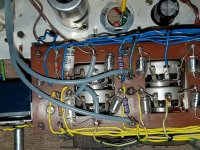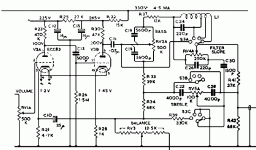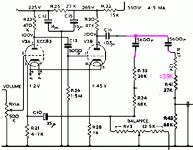Maybe somebody can help me.
I am restoring a set Quad II mono's and a Quad 22.
The mono's are ready to use also with other pre amps is needed but that is not the intention. Fully rewired and new capacitor and resistors and new earth scheme. Wonderful amps. Original schema is used only thing is seperate powertube bias.
The 22 has a separate tube powersupply. Just for fun and to be seperate from the mono's.
In the past weeks I tried to bypass the tonecontrol but without success. On the internet I could not find any solution for that.
Is there somebody who could help me with this?
Thanks in advance!
Ad.

Verstuurd vanaf mijn S7 edge met Tapatalk
I am restoring a set Quad II mono's and a Quad 22.
The mono's are ready to use also with other pre amps is needed but that is not the intention. Fully rewired and new capacitor and resistors and new earth scheme. Wonderful amps. Original schema is used only thing is seperate powertube bias.
The 22 has a separate tube powersupply. Just for fun and to be seperate from the mono's.
In the past weeks I tried to bypass the tonecontrol but without success. On the internet I could not find any solution for that.
Is there somebody who could help me with this?
Thanks in advance!
Ad.

Verstuurd vanaf mijn S7 edge met Tapatalk
Attachments
I have to ask.
You have a classic amplifier system and want to use the original Pre- amp
Not a modern one.
So why butcher the design of the Pre by taking out the tone controls?
Just set them to mid position.
You have a classic amplifier system and want to use the original Pre- amp
Not a modern one.
So why butcher the design of the Pre by taking out the tone controls?
Just set them to mid position.
I have a couple of these preamps, and if I recall correctly if the filter wheel is set to "cancel" the tone controls are bypassed. I seem to recall that they have no effect on the sound unless the filter knob is active. I don't generally use the preamp, so my memory is a little hazy, but you may want to check that, the work may already be done for you.
Sheldon
Sheldon
Hi Sheldon, thanks for your answer.
Still when you choose cancel, it stays in the circuit somehow. I noticed that because one of the capacitors was disconnected and changed the sound.
It is not possible to really bypass it other then remove everything. Still I don't know how to do that...
Ad.
Verstuurd vanaf mijn S7 edge met Tapatalk
Still when you choose cancel, it stays in the circuit somehow. I noticed that because one of the capacitors was disconnected and changed the sound.
It is not possible to really bypass it other then remove everything. Still I don't know how to do that...
Ad.
Verstuurd vanaf mijn S7 edge met Tapatalk
My reading of the circuit diagram is that the filter cancel switch position simply cancels the HF filter, but leaves the tone controls in action.stokessd said:I have a couple of these preamps, and if I recall correctly if the filter wheel is set to "cancel" the tone controls are bypassed.
I can't understand the tone control circuit - I can't even work out whether it is passive or active although I suspect the latter. Very unusual circuit.
Refresh our memories. The first attachment? (With the later mod noted in another thread.)
The tone control is tightly integrated with the gain structure. It is similar to what Steve Dove names "swinging outputs", but inverted with the pots in the top legs. The amplifier makes big signal. The two legs form a bridge. Balanced for pots centered, unbalanced to cause loss in one leg or the other and shift tone.
I have sheared-out the tone networks to show the core action. I do not think you want to do this to a sweet Quad.
The tone control is tightly integrated with the gain structure. It is similar to what Steve Dove names "swinging outputs", but inverted with the pots in the top legs. The amplifier makes big signal. The two legs form a bridge. Balanced for pots centered, unbalanced to cause loss in one leg or the other and shift tone.
I have sheared-out the tone networks to show the core action. I do not think you want to do this to a sweet Quad.
Attachments
Why don't sell the unaltered quad and use some of the money to a cheap chinese preamp that lacks tonecontrols ?Maybe somebody can help me.
I am restoring a set Quad II mono's and a Quad 22.
The mono's are ready to use also with other pre amps is needed but that is not the intention. Fully rewired and new capacitor and resistors and new earth scheme. Wonderful amps. Original schema is used only thing is seperate powertube bias.
The 22 has a separate tube powersupply. Just for fun and to be seperate from the mono's.
In the past weeks I tried to bypass the tonecontrol but without success. On the internet I could not find any solution for that.
Is there somebody who could help me with this?
Thanks in advance!
Ad.
View attachment 586447
Verstuurd vanaf mijn S7 edge met Tapatalk
Or, if you feel for tinkering, a complete new build where you may express
your experimental wishes without limits?
Happy X-mas!
That's not really true, as I experienced severe change in sound when one of the capacitors was loose, the sound changed noticeable.
Verstuurd vanaf mijn S7 edge met Tapatalk
I am not convinced that the tone controls are "bypassed" in the 'cancel' switch position. I believe the manual is misleading. What it may do is somehow force them to act flat, but this leaves open the possibility of a component change (such as the reported loose connection) affecting the sound as the tone controls are based on a bridge configuration.
The controls appear to be fairly tightly integrated into the circuit, so basically you can't remove them or bypass them without completely re-engineering the relevant gain stages. Then you would no longer have a Quad 22. So your choice: a Quad 22 with tone controls, or something else without tone controls.
The controls appear to be fairly tightly integrated into the circuit, so basically you can't remove them or bypass them without completely re-engineering the relevant gain stages. Then you would no longer have a Quad 22. So your choice: a Quad 22 with tone controls, or something else without tone controls.
Switch 3 when fully anticlockwise, shunts the tone control circuit completely and leaves the signal perfectly flat. The tone control is a standard Baxandall style control network utilising inductors for setting the filter slope or tone bending.
It is definitely nothing like a standard Baxandall. However, I can now see where the switches shunt the tone controls so I agree that it should leave it flat. I still can't work out how it works, or even whether the cathode of V3A is a second source for it or a feedback point. Clearly a classic draughtsman's circuit diagram - I wonder if the original designer can follow his own circuit in this rendering?
Perhaps your unit is defective?
Not really 🙂
It's functioning normal but maybe the faulty cap did the something strange.
Doesn't matter. I leave that part as it is. It's just for fun these amps but they can sing, unbelievable, I was very supprised when I first powered them on. I didn't expect that

Thing you could try:-
If you feed a line level source into the "Tape Output" (this connects to the top side of the volume control) you will find it make good line stage, as it bypasses the EF86 input stage.
The "Tone Controls" does have a big effect on the sound and you can hear it when they are switched in circuit. Bass becomes very warm and the treble softens.
I think the sound changes when the "Tone Controls" are switch in is due to the poor drive ability of the ECC83.
The schematic shown the components connected in the "Cancel Position".
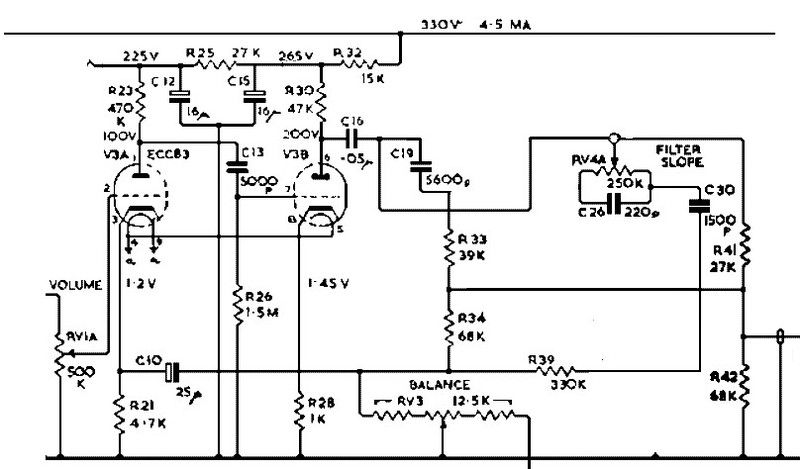
Measuring the original circuit there is a 5db rise a 10hz (not what you want feeding valve power amp).

I've change C13 from 5nF to 820pF and R26 from 1.5M to 1.0M this flattened out the frequency response.
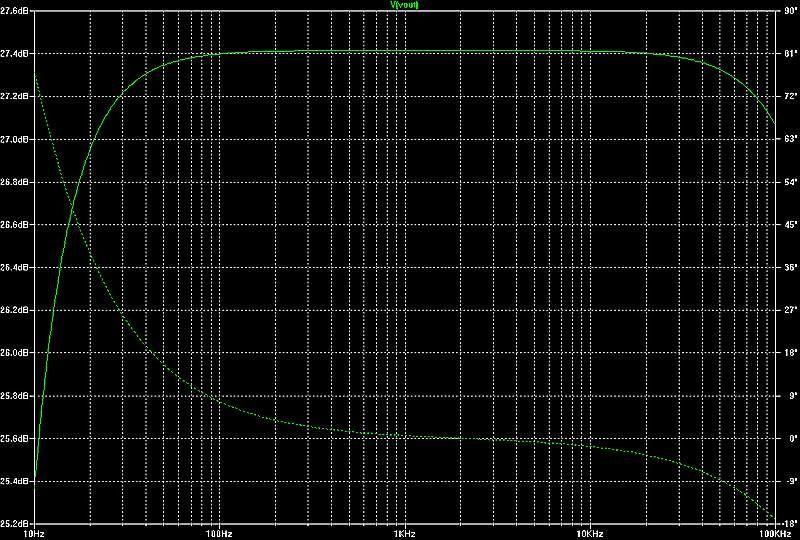
I hope the picture is self explanatory, with the "Tone Control" switch in or out there was very little difference in sound.
The benefits with the mosfet follower allow the preamp to to drive any power amp with an input impedance of 10k.
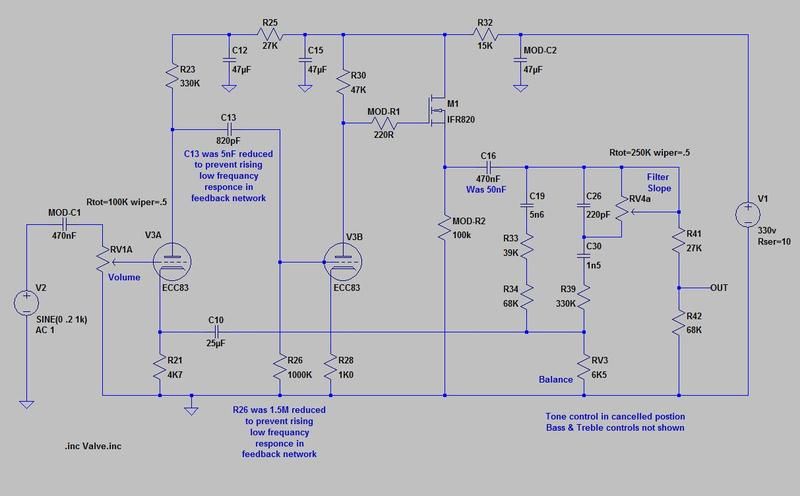
Sharif.
If you feed a line level source into the "Tape Output" (this connects to the top side of the volume control) you will find it make good line stage, as it bypasses the EF86 input stage.
The "Tone Controls" does have a big effect on the sound and you can hear it when they are switched in circuit. Bass becomes very warm and the treble softens.
I think the sound changes when the "Tone Controls" are switch in is due to the poor drive ability of the ECC83.
The schematic shown the components connected in the "Cancel Position".

Measuring the original circuit there is a 5db rise a 10hz (not what you want feeding valve power amp).

I've change C13 from 5nF to 820pF and R26 from 1.5M to 1.0M this flattened out the frequency response.

I hope the picture is self explanatory, with the "Tone Control" switch in or out there was very little difference in sound.
The benefits with the mosfet follower allow the preamp to to drive any power amp with an input impedance of 10k.

Sharif.
For the moment the tonecontrol is removed 🙂 I replaced the complete interior by the audio note ksl m7 pre schema. 6072A in place. Sounding superb I must say. Yes I removed it in a way to revert of I want. 🙂
Verstuurd vanaf mijn S7 edge met Tapatalk
Verstuurd vanaf mijn S7 edge met Tapatalk
It is definitely nothing like a standard Baxandall.
It is exactly like a standard Baxandall tone control section except that the signal is fed in at the wipers instead of being taken off at the wipers. It is just kind of inside-out from that point of view. However the fundamental Baxandall idea of modifying the forward and NFB paths frequently-selectively is still present.
- Status
- Not open for further replies.
- Home
- Amplifiers
- Tubes / Valves
- Quad 22 tone control
